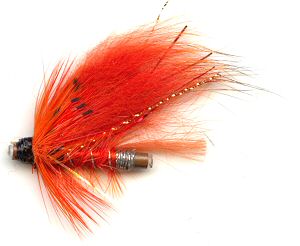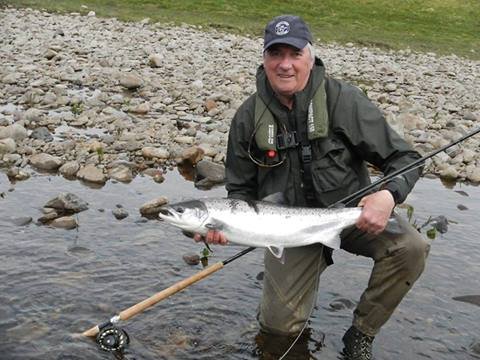The Black Nosed Ally's Shrimp One Inch Copper Tube Fly
The heavy copper tube used in this Black Nosed Ally's Shrimp one inch tube pattern gets this fly fast down to where the salmon fish our feeding. Alistair Gowans created this pattern to simulate the translucent, shrimp like crustaceans he had observed in trawler catches.

SALTWATER, SALMON & STEELHEAD TUBE FLY
$US each. Price does not include hooks.
The question that many fly fishermen ask themselves is do salmon simply take what we offer them or are they really selective. An old salmon fisherman of over 40 years said to me in a Scottish pub over a pint of heavy (Scottish name for ale) ‘I have tried and tried over the years to find out what the Salmon won’t take but have failed miserably. The secret is to get your fly in the right spot’. I still find that you have a better chance of a take with certain style of flies than others depending on the time of year and water conditions.
It is true that certain salmon that have returned to freshwater rivers from a long period in the sea, do not feed. But as many salmon fly fisherman know they can be provoked to snap at an annoying artificial fly that invades their personal space. Now some say this is a reflex feeding instinct whilst others say the salmon are just grumpy and want to kill something. You chose what you want to believe but whichever is the truth this feature of a returning salmon’s behaviour allows us to carry on fly fishing for salmon.

Some Scottish salmon fishermen I have met preach that only a certain fly fishing pattern with a few changes on a certain hook size works in a particular stretch of water. Maybe it is being in the right place at the right time that brings results no matter what fly you have tied on or is it simply that you have mastered the correct presentation method. May be it is just luck which is often the common conclusion of many fishermen who have not caught any fish that day where as his fishing buddy a few yards away has caught four big ones.
The funny thing about luck is that some salmon fishermen are consistently luckier than others. These seem to be the fishermen that spend more time on the water each year and have time to practice their fishing skill again and again. Luck is often the explanation given to conceal a great deal of research and effort.

SALMON TUBE FLIES
Traditional salmon, steelhead and sea trout files were time consuming to tie. The hair-winged versions of these patterns are easier to tie and the fish seem no more reluctant to take them rather than the traditional dressed salmon fly. It was logical that this simplification idea was carried further using probably the most secure hooking device yet invented, the treble hook. The result was a range of tube flies which now account for as many if not more fish each season than do traditional single hook flies. During the early season when the water is cold, tube flies offer the fly fisherman a lure/streamer large enough to tempt what can be very dour fish.
The advantages of the tube fly is pretty impressive. Flies and hooks are separate so you can carry a lot of flies in your shirt pocket and the hooks in a film can. You can use non-stainless steel hooks (which are sharper and stronger) in salt water, just throw them away in a bin when you are finished fishing for the day. You can cater for barbed and barbed-less fishing. You can use treble hooks, or double hooks or single hooks. Most salmon fishermen use a treble hook but the beauty of tube flies is that you can choose what ever hook you want. You can vary the size and type to match the type of fish you are after, the water situation and regulations. If the hook dulls, just replace it instead of sharpening it on the water. The flies are more durable, because when you hook the fish, the fly slides up the leader away from the munching action of your quarry. You can tie huge flies without buying expensive long shanked hooks. Some say they swim better and look more natural
To tie the fly onto the end of your leader, simply pull the hook from the rear of the plastic tube, tie the hook to your leader and re-insert the hook into the tube. If the hook becomes damaged it can be easily replaced without disposing the fly. If you have problems of the hook inserting itself up the tube thread on a bead at the rear of the tube just in front of the hook eye. Always have spare hooks with you.
Winnie Morawski, whilst working for a fly tier Charles Playfair and Company of Aberdeen in Scotland in 1945, is credited with tying the first tube fly. While she was tidying up the turkey quills from her work bench she had a brain wave. She chopped the top and bottom off and scrapped the insides from the quills . She then dressed this natural tube she had created. One of the company's customers was a doctor called William Michie. He liked the idea of tube flies but suggested that cut lengths of surgical tubing should be used instead of the fragile and very brittle quills. Word got around and soon tubes were being tied in Norway, Sweden, Canada, USA as well as the United Kingdom. Saltwater tube flies appeared in the North American Pacific Northwest and were used in Washington State's Puget Sound in the late 1940s
It has been reported that Native North Americans used hollowed out bones as an early tube fly. The marrow was poked out and the bone left in the sun to dry. A long shank hook was then inserted into the hollowed bone unlike the modern tube fly. The bone added weight that sank the hook to the required depth. When it was retrieved through the water after the cast a stream of bubbles left the end of the bone. A few feathers or fur tied to the outside of the bone increased effectiveness. (Although not a tube fly you can see other examples of bone lures in the Honolulu Maritime Museum in Hawaii)
There is one disadvantage with using tube flies. It is nothing to do with the effectiveness of the fly at catching fish but more to do with the wording of local fishing regulations. An example of this is that in America, Washington State a tube fly is defined as a lure and not a fly under their State regulations and therefore can not be used on fly only water. Their regulations define a fly as 'a lure on which thread, feathers, hackle, or yarn cover a minimum of half of the hook shank of the hook'. We only sell plastic tubes. The regulations in Eastern Canada forbid the use of 'weighted flies' for Atlantic Salmon. Metal tube flies are considered 'Weighted flies'. Consult your local fishing regulations before using tube flies to see if they are so narrow minded as those of Washington State.
On very cold days the water temperature seems to take the enthusiasm to feed or bite out of some fish. They head deep. In these circumstances you must get your fly down to the bottom with sinking or sinking tip lines. I have found that on the times when I have used heavy hooked regular flies they have become embedded in the bottom, snagged. I have found when I use plastic tube flies and a smaller shanked hook the fly rides higher. I have therefore noticed a great reduction in the amount of large hooked flies that I have had to leave adding to the decoration of lake and river bottoms. If you have spotted a large wise old trophy fish and need some thing very large to attract him tube flies are ideal. Tie on two or three tube flies one behind the other. You now have what looks like a tempting big meal for a big hungry fish.
I prefer using these lighter plastic tube flies than copper or brass tubes. I find the lighter tube fly, in slow or medium flowing rivers, tends to flutter very attractively as it swings across the current mimicking the natural movement of bait fish or a shrimp. I use a fast sinking line to get the fly down to the required depth. It makes the fly swim more naturally. In deep water on lakes and reservoirs the copper weighted tube flies come into their own realm.


Salmon fishing books

